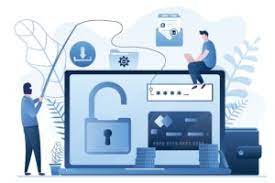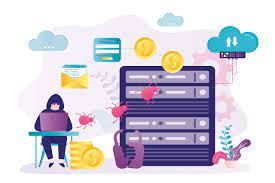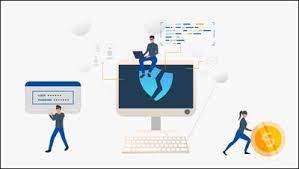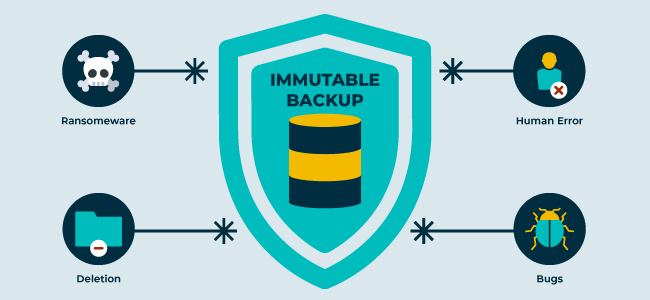Hello!
 With so many threats lurking around every corner of the web, keeping your data safe can seem like an impossible feat these days. This is especially true when you consider how even some of the largest corporations and government organizations have fallen victim to cyber threats within the last several years. If a company with access to some of the most sophisticated security technology in the world can’t prevent online attacks, how do you stand a chance?
With so many threats lurking around every corner of the web, keeping your data safe can seem like an impossible feat these days. This is especially true when you consider how even some of the largest corporations and government organizations have fallen victim to cyber threats within the last several years. If a company with access to some of the most sophisticated security technology in the world can’t prevent online attacks, how do you stand a chance?
One of the most widespread types of web attacks these days is ransomware, which can quite literally take your data for ransom. And unfortunately, even data backups can fall victim to this threat.
The good news? By having a better understanding of how ransomware attacks work and the steps you can take to protect your backups, you can drastically reduce your chances of falling victim.
How Ransomware Attacks Work
 So, how do ransomware attacks happen in the first place? Specifically, ransomware is a type of malware that is designed to “lock down” the files and data on your device by encrypting them. This prevents you from being able to access the data without actually destroying it. From there, the entity controlling the ransomware itself can request a “ransom” to be paid in exchange for the decryption code that will restore access to your files.
So, how do ransomware attacks happen in the first place? Specifically, ransomware is a type of malware that is designed to “lock down” the files and data on your device by encrypting them. This prevents you from being able to access the data without actually destroying it. From there, the entity controlling the ransomware itself can request a “ransom” to be paid in exchange for the decryption code that will restore access to your files.
Ransomware can come from a wide range of sources, but it is most often sent through email, text messages, or social media messages.
When the victim clicks on a file/download thinking that it is a legitimate file, the malware can infect the device’s hard drive(s) and hold those files hostage until the attack is complete.
The Dangers of Ransomware Attacks
 Unfortunately, instances of ransomware attacks have been increasing for years — and they don’t show any signs of stopping anytime soon. In fact, the size and scope of ransomware attacks have increased significantly, and ransom amounts (the amount victims payout to regain access to their data) have also increased by a whopping 171% since 2019 alone.
Unfortunately, instances of ransomware attacks have been increasing for years — and they don’t show any signs of stopping anytime soon. In fact, the size and scope of ransomware attacks have increased significantly, and ransom amounts (the amount victims payout to regain access to their data) have also increased by a whopping 171% since 2019 alone.
Combine this with the fact that ransomware attackers are going after not just individuals, but companies of all sizes, and it’s easy to see why this is a threat that nobody can afford to ignore.
In addition to the financial havoc that a ransomware attack can wreak, there’s also the simple fact that paying a ransom never guarantees that the attackers will keep their word and provide a victim with a legitimate decryption code. Even if the code/key works, there is always the possibility that the attacker will leak sensitive data or go after the same victims again. With this in mind, recovering from a ransomware attack can be very difficult.
How to Protect Your Backups From Ransomware
The good news is that there are steps you can take to protect your data backups from ransomware attacks. This all begins with choosing the right security solutions for your specific needs. Consider, for example, hiring a cybersecurity professional to run a security audit on your infrastructure. This can be a great way to reveal potential shortcomings in your security measures that can be easily rectified to improve protection. Recommended measures could range anywhere from installing a virus protection program and implementing a firewall to setting up additional data backups or other cybersecurity measures.
 From there, don’t overlook the importance of common sense when it comes to cybersecurity best practices. This is true not just for you personally, but for anybody else who may have shared access to your data.
From there, don’t overlook the importance of common sense when it comes to cybersecurity best practices. This is true not just for you personally, but for anybody else who may have shared access to your data.
For larger corporations, this may mean providing in-depth cybersecurity training to employees often.
Even though you might know that you should never open a link from an email address you don’t recognize, you should never assume that others within your organization share this same knowledge.
Take the time to train your employees on how to detect common ransomware threats and how to report them. This can go a long way in protecting your information from these attacks.
Likewise, remember the rule of three when it comes to storing your important data. Every file should be stored in at least three locations: one on your system, one on a different type of reliable media (such as an external hard drive or flash drive), and one completely off-site (such as on a third-party dedicated server with DDoS protection). This way, even if one of your drives is infected with malware, you will still have access to the compromised files on other backups so they aren’t entirely lost.
 Of course, simply having data backups in place may not be enough if you’re not taking the time to back up your data regularly. The frequency with which your files should be backed up will ultimately depend on many factors, ranging from the size of your organization to how often your files change/update.
Of course, simply having data backups in place may not be enough if you’re not taking the time to back up your data regularly. The frequency with which your files should be backed up will ultimately depend on many factors, ranging from the size of your organization to how often your files change/update.
Regardless, it’s important to have a backup schedule in place that you can easily follow. If you think you’ll have a hard time remembering to back up your data when needed, you might want to set up automatic backups instead.
Last but not least, be sure to have a game plan in place for how you (or your organization as a whole) would handle a ransomware event.
It’s not a fun thing to think about or plan for, but you need to know whether you will plan on paying the ransom (or how much you are willing to pay before exploring alternate options).
While many people choose to pay the ransom when they fall victim to this type of attack, it may not always be the best choice. Make sure everybody within your organization knows the protocol for a ransomware attack and how to follow it. This should include a protocol on how to report an attack (or suspected attack) as soon as it occurs.
Also read:
- System Security and Error Management in 2025
- Top 7 Habits You must Practice if you want to Be Highly Effective
- Are Your Instagram Filters Helping or Hurting Engagement?
The Bottom Line on Ransomware and Backups
 Nobody wants to plan for ransomware attacks. Unfortunately, this type of malware has become so widespread that it’s something every web user should be thinking about. By understanding how these attacks work and the measures you can take to protect your data backups from ransomware, you can avoid becoming a victim. Likewise, if you do fall victim to a ransomware attack, having a plan in place will expedite the process of restoring your data and getting back to business “as usual.”
Nobody wants to plan for ransomware attacks. Unfortunately, this type of malware has become so widespread that it’s something every web user should be thinking about. By understanding how these attacks work and the measures you can take to protect your data backups from ransomware, you can avoid becoming a victim. Likewise, if you do fall victim to a ransomware attack, having a plan in place will expedite the process of restoring your data and getting back to business “as usual.”
Through the use of antivirus software and firewalls, extensive cybersecurity training, and the “rule of threes” for data backups, you can keep your most sensitive information safe.
Thank you!
Join us on social media!
See you!






